

Riyad-us Saliheen Brigade of Martyrs. Riyad-us Saliheen (Russian: Риядус-Салихийн, also transliterated as Riyadus-Salikhin, Riyad us-Saliheyn or Riyad us-Salihiin) is the name of a small "martyr" (shahid) force of Islamic suicide attackers.
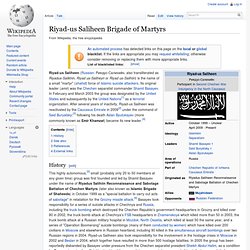
Its original leader (amir) was the Chechen separatist commander Shamil Basayev. 7 July 2005 London bombings. The 7 July 2005 London bombings (often referred to as 7/7) were a series of coordinated suicide attacks in central London, which targeted civilians using the public transport system during the morning rush hour.

On the morning of Thursday, 7 July 2005, four Islamist men detonated four bombs—three in quick succession aboard London Underground trains across the city and, later, a fourth on a double-decker bus in Tavistock Square. 2004 Madrid train bombings. Abu Sayyaf. Abu Sayyaf ( Since its inception in the early 1990s, the group has carried out bombings, kidnappings, assassinations and extortion[8] in what they describe as their fight for an independent Islamic province in the Philippines.[9] Abu Sayyaf seeks the establishment of an Iranian-style Islamic theocracy in the southern Philippines.[10] Abu Sayyaf forces in Basilan and in Zamboanga Peninsula were, by June 2003, believed to number less than 500, down from more than 1,000 a year earlier.
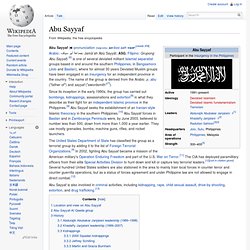
They use mostly grenades, bombs, machine guns, rifles, and rocket launchers. Islamic insurgency in the Philippines. In 1969, political tensions and open hostilities developed between the Government of the Philippines and jihadist rebel groups.[14] The Moro National Liberation Front (MNLF) was established by University of the Philippines professor Nur Misuari to condemn the killings of more than 60 Filipino Muslims and later became an aggressor against the government while the Moro Islamic Liberation Front (MILF), a splinter group from the MNLF, was established to seek an Islamic state within the Philippines and is more radical and more aggressive.

Conflict dates back to 1899 during the uprising of the Bangsamoro people to resist foreign rule from the United States. Hostilities ignited again starting in the 1960s when the government started to resist upcoming rebellions by killing more than 60 Filipino Muslims and continues up to present. Origins[edit] Mughal Empire. The Mughal Empire (Urdu: مغلیہ سلطنت, Mug̱ẖliyah Salṭanat),[4] self-designated as Gurkani (Persian: گورکانیان, Gūrkāniyān),[5] was an empire extending over large parts of the Indian subcontinent and ruled by a dynasty of Chagatai-Turkic origin.[6][7][8] In the early 16th century, northern India, being then under mainly Muslim rulers, fell to the superior mobility and firepower of the Mughals.

The resulting Mughal Empire did not stamp out the local societies it came to rule, but rather balanced and pacified them through new administrative practices and diverse and inclusive ruling elites, leading to more systematic, centralised, and uniform rule. Eschewing tribal bonds and Islamic identity, especially under Akbar, the Mughals united their far-flung realms through loyalty, expressed through a Persianised culture, to an emperor who had near-divine status. Battle of Talas. Yom Kippur War. The Yom Kippur War, Ramadan War, or October War (Hebrew: מלחמת יום הכיפורים Milẖemet Yom HaKipurim or מלחמת יום כיפור Milẖemet Yom Kipur; Arabic: حرب أكتوبر ḥarb ʾUktōbar, or حرب تشرين ḥarb Tišrīn), also known as the 1973 Arab–Israeli War, was a war fought by the coalition of Arab states led by Egypt and Syria against Israel from October 6 to 25, 1973.

The war began when the Arab coalition launched a joint surprise attack on Israeli positions in the Israeli-occupied territories on Yom Kippur, the holiest day in Judaism, which occurred that year during the Muslim holy month of Ramadan. Egyptian and Syrian forces crossed ceasefire lines to enter the Sinai Peninsula and Golan Heights respectively, which had been captured by Israel in the 1967 Six-Day War.
Both the United States and the Soviet Union initiated massive resupply efforts to their respective allies during the war, and this led to a near-confrontation between the two nuclear superpowers.[44] Background According to Chaim Herzog: Six-Day War. The Six-Day War (Hebrew: מלחמת ששת הימים, Milhemet Sheshet Ha Yamim; Arabic: النكسة, an-Naksah, "The Setback" or حرب ۱۹٦۷, Ḥarb 1967, "War of 1967"), also known as the June War, 1967 Arab–Israeli War, or Third Arab–Israeli War, was fought between June 5 and 10, 1967, by Israel and the neighboring states of Egypt (known at the time as the United Arab Republic), Jordan, and Syria.

The war began on June 5 with Israel launching surprise strikes against Egyptian air-fields in response to the mobilisation of Egyptian forces on the Israeli border. A period of high tension had preceded the war. Background and summary of events leading to war After the 1956 Suez Crisis, there were numerous minor border clashes between Israel and its Arab neighbors, particularly Syria. On November 4, 1966, the Soviet Union vetoed a six-Power resolution inviting Syria to prevent incidents that constituted a violation of the General Armistice Agreement.[24] Events: Israel–Jordan Events: Israel–Syria Arab preparations. 2006 Lebanon War. Smoke over Haifa, Israel, after a rocket launched by Hezbollah hit the city near Bnei-Zion hospital The conflict was precipitated by Zar'it-Shtula incident, On 12 July 2006, militants from the group Hezbollah fired rockets at Israeli border towns as a diversion for an anti-tank missile attack on two armored Humvees patrolling the Israeli side of the border fence.[36] The ambush left three soldiers dead.
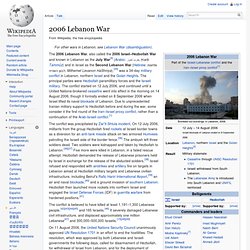
Two soldiers were kidnapped and taken by Hezbollah to Lebanon.[36][37] Five more were killed in Lebanon, in a failed rescue attempt. Hezbollah demanded the release of Lebanese prisoners held by Israel in exchange for the release of the abducted soldiers.[38] Israel refused and responded with airstrikes and artillery fire on targets in Lebanon aimed at Hezbollah military targets and Lebanese civilian infrastructure, including Beirut's Rafic Hariri International Airport,[39] an air and naval blockade,[40] and a ground invasion of southern Lebanon. Background[edit] Gaza War. The Gaza War, also known as Operation Cast Lead (מבצע עופרת יצוקה) and Gaza Massacre (مجزرة غزة)[38][39][40] or the Battle of al-Furqan [the criterion] (معركة الفرقان)[41][42] was a three-week armed conflict in the Gaza Strip between Israel and Palestinian militants that began on 27 December 2008 and ended on 18 January 2009 in a unilateral ceasefire.[43] Israel's stated goal was to stop rocket fire into Israel[44] and weapons smuggling into the Gaza strip.[45][46] After the beginning of the conflict, Palestinian groups continued firing rockets in response to what they characterized as "massacres".[47] Israeli forces attacked police stations, military targets including weapons caches and suspected rocket firing teams,[48] as well as political and administrative institutions in the opening assault, striking in the densely populated cities of Gaza, Khan Yunis and Rafah.[49] An Israeli ground invasion began on January 3.
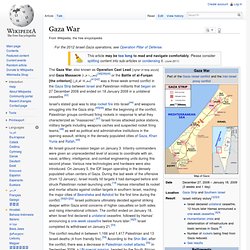
Background[edit] 2008 six-month lull[edit] Iraq War. Prior to the war, the governments of the United States and the United Kingdom claimed that Iraq's alleged possession of weapons of mass destruction (WMD) posed a threat to their security and that of their coalition/regional allies.[49][50][51] In 2002, the United Nations Security Council passed Resolution 1441 which called for Iraq to completely cooperate with UN weapon inspectors to verify that Iraq was not in possession of WMD and cruise missiles.
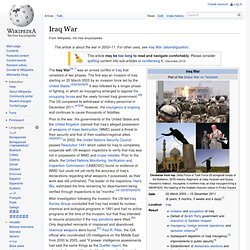
Prior to the attack, the United Nations Monitoring, Verification and Inspection Commission (UNMOVIC) found no evidence of WMD, but could not yet verify the accuracy of Iraq's declarations regarding what weapons it possessed, as their work was still unfinished. The leader of the inspectors, Hans Blix, estimated the time remaining for disarmament being verified through inspections to be "months".
[nb 2][52][53][54][55] Background[edit] Iraq disarmament and pre-war intelligence[edit] UN weapons inspections resume[edit] Invasion of Dagestan (1999) The Invasion of Dagestan,[4] also known as the War in Dagestan[5] and Dagestan War,[6] began, when the Chechnya-based Islamic International Brigade (IIB), an Islamist militia, led by warlords Shamil Basayev and Ibn al-Khattab, invaded the neighbouring Russian republic of Dagestan on 2 August 1999, in support of the Shura of Dagestan separatist rebels. The war ended with a major Russian victory and the retreat of the IIB.
The Invasion of Dagestan served as the casus belli for the Second Chechen War. Background[edit] During the inter-war period from 1996 to 1999, war-ravaged Chechnya descended into anarchy and economic collapse. Aslan Maskhadov's government was unable to rebuild the region and to prevent a number of warlords from taking effective control. Second Chechen War. On 1 October Russian troops entered Chechnya.[23][24] The campaign ended the de facto independence of Chechen Republic of Ichkeria and restored Russian federal control over the territory.
Although it is regarded by many as an internal conflict within the Russian Federation, the war attracted a large number of foreign fighters. As of 2009, Russia has severely disabled the Chechen separatist movement and large-scale fighting has ceased. Russian army and interior ministry troops no longer occupy the streets. The once-leveled city of Grozny has recently undergone massive reconstruction efforts and much of the city and surrounding areas have been rebuilt at a quick pace. Fall of Constantinople. Battle of Vienna. Ottoman Empire. The Ottoman Empire (/ˈɒtəmən/; Ottoman Turkish: دَوْلَتِ عَلِيّهٔ عُثمَانِیّه, Devlet-i Aliyye-i Osmâniyye, Modern Turkish: Osmanlı İmparatorluğu or Osmanlı Devleti), also historically referred to as the Turkish Empire or Turkey, was a Sunni Islamic state founded in 1299 by Oghuz Turks under Osman I in northwestern Anatolia.[7] With conquests in the Balkans by Murad I between 1362 and 1389, the Ottoman sultanate was transformed into a transcontinental empire and claimant to caliphate.
Muslim conquests. 2008 Mumbai attacks. Moscow theater hostage crisis. Beslan school hostage crisis. 2007 bomb plot in Germany. The 2007 bomb plot in Germany (German: Sauerland-Gruppe, "Sauerland Group") was discovered following an extensive nine-month investigation, involving some 300 people,[1] three men were arrested on 4 September 2007 while leaving a rented cottage[2] in the Oberschledorn district of Medebach, Germany where they were alleged to have stored 700 kg (1,500 lb) of a hydrogen peroxide-based mixture and 26 military-grade detonators[3][4] and were attempting to build car bombs.[5] Perpetrators[edit] The three suspects were all unemployed.[6] Two were German converts to Islam from Christianity,[7] who had attended Pakistani camps run by Islamic Jihad Union.[8] Fritz Gelowicz (born 1979), was born in Munich and moved to Ulm with his parents and brother at the age of 5.
Strasbourg Cathedral bombing plot. The Strasbourg Cathedral bombing plot was an al-Qaeda plan to bomb the Strasbourg Christmas market (Christkindelsmärik) at the feet of Strasbourg Cathedral during the Christmas celebrations of 2000.[1] It was prevented by French and German police.[2] In March 2003, four suspects linked to the terror plot were sentenced to between 10 and 12 years imprisonment by a court in Frankfurt am Main, Germany. The German court said the group had planned to blow up pressure cookers packed with explosives, a technique they allegedly learned in Afghan camps. In December 2004, ten other suspected Islamic militants were jailed in Paris for their part in the failed plot. These suspects – all Algerian or French-Algerian[3][4] – were sentenced to terms of up to 10 years. One of the convicted persons was said to have been an associate of al-Qaeda leader Osama Bin Laden.